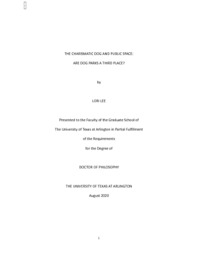
ATTENTION: The works hosted here are being migrated to a new repository that will consolidate resources, improve discoverability, and better show UTA's research impact on the global community. We will update authors as the migration progresses. Please see MavMatrix for more information.
Show simple item record
| dc.contributor.advisor | Audirac, Ivonne | |
| dc.creator | Lee, Lori Dynette | |
| dc.date.accessioned | 2022-01-20T18:09:45Z | |
| dc.date.available | 2022-01-20T18:09:45Z | |
| dc.date.created | 2020-08 | |
| dc.date.issued | 2020-09-04 | |
| dc.date.submitted | August 2020 | |
| dc.identifier.uri | http://hdl.handle.net/10106/30177 | |
| dc.description.abstract | Exiting research supports dog parks as a third place based on the ability of dog-supportive public space to bring people together informally outside home and work (Graham and Glover, 2014), yet offers little clarity in terms of strength of interaction. Ray Oldenburg (1989), the originator of the notion of third place, stresses the importance of certain contexts in supporting repeat encounters, which he explains are of crucial importance to effective third places, while lamenting their absence in suburban America. A careful review of his work in this dissertation raises the question, is a dog park within a suburban Dallas context capable of supporting an effective third place?
This research consists of two case studies. The first compares social interaction within two dog parks, one in New Urban Addison Circle, a mixed use, compact neighborhood, and the other located nearby within a traditional suburban North Dallas neighborhood considering two dog parks are comparable in terms of watering and facilities. A second case study controls for context by comparing the social interaction within one of these dog parks with a small urban non-dog park within the same New Urban neighborhood and two blocks away. This study’s overall thesis is that to qualify as an effective third place, parks must meet detailed criteria as laid out by Oldenburg (1989). The study’s main research questions address the following additional theses: 1) Social interaction in dog parks can go beyond casual greetings associated with urban parks to be stimulators of meaningful face-to-face social interaction; 2) The neighborhood’s urban densities and mixtures of use may modulate the effectiveness of face-to-face interaction and strength of ties occurring in dog parks.
Data derived from six weeks of observation and interviews of users within these parks compare macro- and micro-level contextual variations against the rate, quality, and strength of social interaction taking place in each park. The research supports the dog park as a third place in either the suburban or urban setting, while concluding stronger ties may be associated with the New Urban context. | |
| dc.format.mimetype | application/pdf | |
| dc.language.iso | en_US | |
| dc.subject | Dog | |
| dc.subject | Park | |
| dc.subject | New | |
| dc.subject | Urban | |
| dc.subject | Planning | |
| dc.subject | Context | |
| dc.subject | Social | |
| dc.subject | Interaction | |
| dc.subject | Suburban | |
| dc.subject | Sense | |
| dc.subject | Community | |
| dc.subject | Tie | |
| dc.subject | Strength | |
| dc.subject | Mixed | |
| dc.subject | Use | |
| dc.subject | Density | |
| dc.subject | Pathway | |
| dc.subject | Walkability | |
| dc.subject | Walking | |
| dc.subject | Sociability | |
| dc.subject | Sociology | |
| dc.subject | Landscape | |
| dc.subject | Architecture | |
| dc.title | THE CHARISMATIC DOG AND PUBLIC SPACE: ARE DOG PARKS A THIRD PLACE? | |
| dc.type | Thesis | |
| dc.degree.department | Urban and Public Affairs | |
| dc.degree.name | Doctor of Philosophy in Urban Planning and Public Policy | |
| dc.date.updated | 2022-01-20T18:09:46Z | |
| thesis.degree.department | Urban and Public Affairs | |
| thesis.degree.grantor | The University of Texas at Arlington | |
| thesis.degree.level | Doctoral | |
| thesis.degree.name | Doctor of Philosophy in Urban Planning and Public Policy | |
| dc.type.material | text | |
Files in this item
- Name:
- LEE-DISSERTATION-2020.pdf
- Size:
- 16.13Mb
- Format:
- PDF
This item appears in the following Collection(s)
Show simple item record


